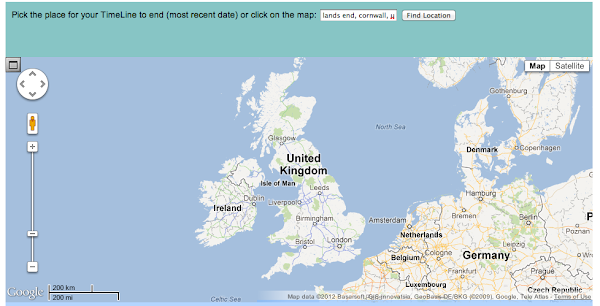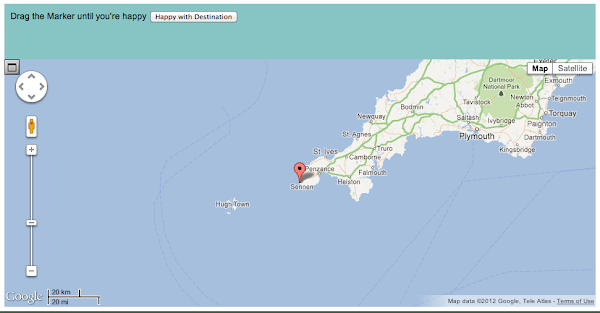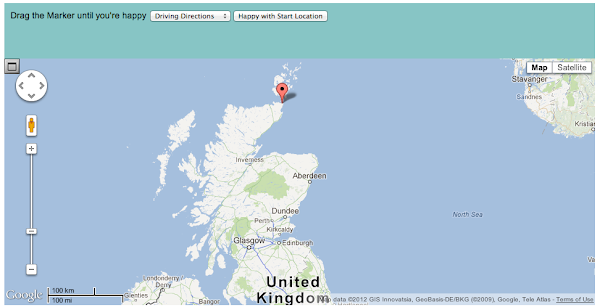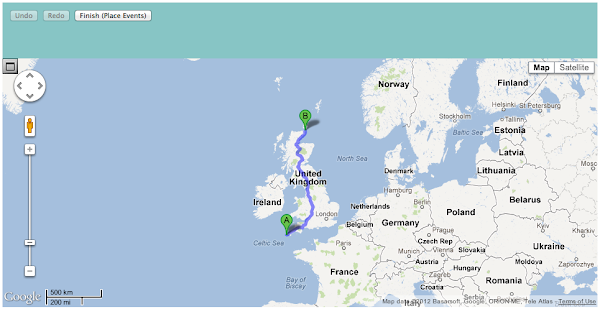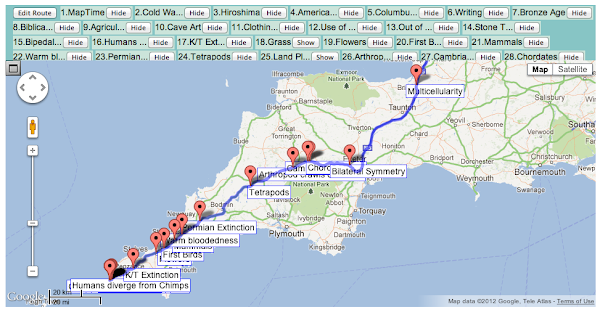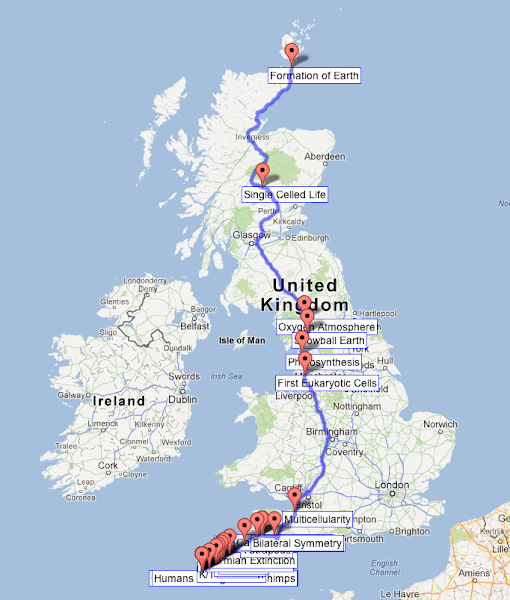The current
Organic Evolution TimeLine has now (finally!) been given a once over to standardise Keywords and remove a few minor typos and errors. (Please report any remaining ones you spot.) The descriptions remain quite short (and URLs are plain text rather than hyperlinked) for now due to technical reasons but hopefully will be expanded in the reasonable near future.
Along with the other TimePoints currently in the system, these can now be found on the
Extended MapTime Glossary page. (The
MapTime Glossay does not have TimePoints or Keywords in it.) The TimePoints and Keywords are also summarised below. (Note that on the
MapTime website, it is now possible to sort these TimePoints by date, name or edit date.)
A
~ B
~ C
~ D
~ E
~ F
~ G
~ H
~ I
~ K
~ L
~ M
~ O
~ P
~ S
~ T
~ U
~ W
A
Agriculture & villages.
(
TimePoint) 10
kya. The beginning of civilization as various
plants and
animals were domesticated during the
Neolithic Revolution. Source:
New Scientist. (Keywords:
history,
human,
technology).
American Independence.
(
TimePoint) 1776 AD, 4 July. The US declared independence from the British Empire. Source:
Wikipedia. (Keywords:
history).
Animal.
(
Keyword)
TimePoints referring to key events in animal
evolution.
Archaeopteryx (early birds).
(
TimePoint) 150
mya. Archaeopteryx the most famous fossil in the
evolutionary history of birds. Early bird
evolution is still subject to debate. Source:
New Scientist (Keywords:
animal,
evolution, fossils).
Arthropod crawls onto land.
(
TimePoint) 500
mya. First exploration of land by euthycarcinoids. Source:
New Scientist. (Keywords:
animal,
evolution).
B
BYA.
Billion years ago.
Biblical Creation Myth.
(
TimePoint) 6000 BC. Consensus age of the Earth from calculations based on the Old Testament Creation myth. This
TimePoint featured in the original MapTime paper but has been taken out of the default
TimeLine as it stood out as the only non-factual event. We might add an "Age of the Earth"
TimeLine, which shows how (much) our understanding has changed over time. Source:
AnswersInGenesis.
Bilateral Symmetry.
(
TimePoint) 630
mya.
Animals evolve bilateral symmetry (a defined "top" and "bottom") as seen in early worm fossils. Source:
New Scientist. (Keywords:
animal,
evolution, fossils).
Bipedal walking.
(
TimePoint) 5.8
mya. Possible bipedal hominids (
Orrorin tugenensis). Source:
New Scientist (Keywords:
evolution, fossils,
human).
Bronze Age.
(
TimePoint) 5.5
kya.
Humans learn to make and use of bronze. Source:
New Scientist. (
history,
human,
technology).
C
Cambrian Explosion.
(
TimePoint) 535
mya. The appearance during the Cambrian of fossils for most major
animal phyla body forms over a few million years. Source:
New Scientist (
animal,
evolution, fossils,
geology).
Cave Art.
(
TimePoint) 35
kya. Cave art in Chauvet, France. Source:
New Scientist (Keywords:
history,
human).
Chordates.
(
TimePoint) 540
mya. First chordates arise. Source:
New Scientist. (Keywords:
animal,
evolution).
Climate.
(
Keyword)
TimePoints referring to key climate events in the Earth's past.
Clothing/Jewellery.
(
TimePoint) 72
kya. Earliest known clothing and jewellery. Source:
New Scientist. (Keywords:
history,
human,
technology).
Cold War Ends.
(
TimePoint) 1989 AD, 2 December. Bush and Gorbachev announce the end of the Cold War at the Malta summit. The Soviet Union dissolves two years later. Source:
Wikipedia. (Keywords:
history).
Columbus "discovers" America.
(
TimePoint) 1492 AD. Christopher Columbus lands in the Bahamas archipelago during an attempted round-the-world voyage to reach Japan. Source:
Wikipedia. (Keywords:
history).
D
Destination.
The end point for your
TimeRoute where the final
TimePoint will be placed. Typically, the present day (represented in the default
TimeLine by the creation of MapTime).
E
Eukaryotic Cells.
(
TimePoint) 2
bya. Eukaryotes arise by endosymbiosis. Source:
New Scientist (Keywords:
animal,
evolution,
plant).
Evolution.
(
Keyword)
TimePoints referring key events in
organic evolution.
Evolutionary history.
See
evolution.
F
Flowers.
(
TimePoint) 130
mya. The first angiosperms (flowering plants) emerge. Source:
New Scientist (Keywords:
evolution,
plant).
Formation of Earth.
(
TimePoint) 4.54
bya. Approximate age of Earth. (Time of accretion not known.) Source:
Wikipedia. (Keywords:
geology).
G
Geology.
(
Keyword)
TimePoints referring to key geological events in the Earth's past.
Grass.
(
TimePoint) 70
mya. First grasses evolve. Source:
New Scientist (Keywords:
evolution,
plant).
H
Hiroshima.
(
TimePoint) 1945 AD, 6 August. The first use of an atomic weapon. A 13-18 kt atomic bomb was dropped on the Japanese city of Hiroshima during the latter stages of WWII. Source:
Wikipedia. (Keywords:
history,
technology).
History.
(
Keyword)
TimePoints referring to events from
human history.
Homo sapiens appears.
(
TimePoint) 195
kya. The first
Homo sapiens. Anatomically modern
humans appear 100-300kya. See
blog entry for more details. Source:
New Scientist. (Keywords:
evolution,
human).
Human.
(
Keyword)
TimePoints referring to human
evolution or
history, including pre-historic non-organic events such as the invention of
stone tools.
Humans diverge from Chimps.
(
TimePoint) 6
mya. Most recent common ancestor of
humans and chimps. Source:
New Scientist. (Keywords:
animal,
evolution,
human).
I
Insects and woody plants.
(
TimePoint) 400
mya First insects and woody plants. Source:
New Scientist. (Keywords:
animal,
evolution,
plant).
K
K/T Extinction.
(
TimePoint) 65
mya. The mass extinction at the Cretaceous-Tertiary boundary. End of the dinosaurs. Source:
New Scientist. (Keywords:
animal,
evolution, fossils).
KYA.
Thousand years ago.
Keyword.
Each
TimePoint is tagged with a number of keywords. These are predominantly to aid searching for custom
TimeLine assembly.
L
Land Plants.
(
TimePoint) 465
mya.
Plants begin colonizing the land. Source:
New Scientist. (Keywords:
evolution,
plant).
M
MYA.
Million years ago.
Major Transitions.
The "Major Transitions" in
evolution represent key events that appear to have happened once in
evolutionary history.
Mammals.
(
TimePoint) 180
mya. Monotremes diverge from other mammals. Source:
New Scientist (Keywords:
animal,
evolution).
Multicellularity.
(
TimePoint) 900
mya. First multicellular organisms. One of the
Major Transitions in
evolution. Source:
New Scientist. (Keywords:
animal,
plant,
evolution).
O
Organic Evolution.
(
TimeLine) The default
TimeLine based loosely on the MapTime paper plotting the
evolution of life on Earth. Makes heavy use of
The New Scientist Evolution of Life website.
Out of Africa.
(
TimePoint) 1.8
mya. The first migration of
human ancestors out of Africa. Source:
New Scientist (Keywords:
evolution,
human).
Oxygen Atmosphere.
(
TimePoint) 2.4
bya. Oxidizing atmosphere appears. Source:
New Scientist. (Keywords:
climate).
P
Permian Extinction.
(
TimePoint) 250
mya. The largest mass extinction in Earth's
history, at the end of the Permian. Source:
New Scientist. (Keywords:
evolution, fossils,
geology).
Photosynthesis.
(
TimePoint) 2.15
bya. Earliest undisputed cyanobacteria fossils. Source:
New Scientist. (Keywords:
evolution, fossils,
plant).
Plant.
(
Keyword)
TimePoints referring to key events in plant
evolution.
S
Single Celled Life.
(
TimePoint) 3.5
bya. Oldest single celled fossil. Source:
New Scientist. (Keywords:
evolution, fossils).
Snowball Earth.
(
TimePoint) 2.3
bya. Extreme global
climate change as Earth freezes over. Source:
New Scientist. (Keywords:
geology,
climate).
Starting Point.
This refers to the first (oldest)
TimePoint on the
TimeLine. MapTime is designed to visualises a
TimeLine as a journey that ends at the current location representing the present day.
Stone Tools.
(
TimePoint) 2.5
mya. First stone tools. Source:
New Scientist. (Keywords:
human,
evolution,
technology).
T
Technology.
(
Keyword)
TimePoints reflecting technological advances in
human history or pre-history.
Tetrapods.
(
TimePoint) 397
mya. First evidence for tetrapods (four-legged animals). Source:
New Scientist. (Keywords:
animal,
evolution).
TimeLine.
A TimeLine is a collection of TimePoints, usually grouped by a particular theme. The Default TimeLine is
Organic Evolution TimeLine based on the MapTime paper.
TimePoint.
A TimePoint is an event on a
TimeLine that will be mapped onto the appropriate place along the
TimeRoute. The youngest TimePoint is first placed at the
destination of the route, the youngest is placed at the
starting point and then the remaining points are spaced out according to scale along the route plotted by Google Maps.
TimeRoute.
Once a
TimeLine has been plotted on Google Maps, it is known as a TimeRoute.
U
Use of Fire.
(
TimePoint) 1.6
mya.
Human ancestors first use fire. Source:
New Scientist (Keywords:
human,
evolution,
technology).
W
Warm bloodedness.
(
TimePoint) 200
mya. Earliest warm blooded proto-mammals. Source:
New Scientist. (Keywords:
animal,
evolution).
Writing.
(
TimePoint) 5
kya. The first writing is developed by the Sumerians in southern Mesopotamia. Source:
New Scientist. (Keywords:
human,
history,
technology).
 The MapTime server is back online after a small glitch with the server hosting our server.
The MapTime server is back online after a small glitch with the server hosting our server. 


